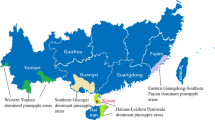Abstract
In experiments to study the effect of inbreeding, I1 progenies of summer cauliflower showed a trend towards increase in plant weight over their non-inbred commercial parents. Curd quality, however, showed no significant improvement.
As summer cauliflower varieties tended to behave as pure lines, studies were made on F1's from crosses between five commercial varieties. The main results of hybridisation were an increase in earliness, and a slight, though significant increase in curd size over the parental varieties. It is suggested that summer cauliflowers have attained a state of homozygous balance, which could be emulated in the autumm and winter types, by selection of self-compatible individuals.
Similar content being viewed by others
References
Anstey, T. H., 1954. Self-incompatibility in green sprouting broccoli (B. oleracea L. var. italica Plenck) I. Its occurrence and possible use in a breeding programme. Canad. J. Agric. Sci. 34: 59–64.
Bateman, A. J., 1954. Self-incompatibility systems in Angiosperms II. Iberis amara. Heredity 8: 305–332.
Jinks, J. L. and Mather, K., 1955. Stability in development of heterozygotes and homozygotes. Proc. Roy. Soc. B. 143: 561–578.
Khan, A. R. and Waheed, G. A., 1959. The effect of different pollination treatments on seed formation and size of head in the next generation of cauliflower (Brassica oleracea var. botrytis L.) Pakistan J. Sci. Res. 11: 12–19.
Lerner, I. M., 1954. Genetic homeostasis. J. Wiley & Sons, N. York.
Lewis, D., 1954. Comparative incompatibility in angiosperms and fungi. Advanc. Genet. 6: 235–285.
Lewis, D., 1954a. Gene-environment interaction. A relationship between dominance, heterosis, phenotypic stability and variability. Heredity 8: 333–356.
Moore, J. F. and Anstey, T. H., 1954. A study of the degree of natural selfing in green sprouting broccoli (B. oleracea L. var. italica). Proc. Amer. Soc. Hort. Sci. 63: 440–442.
Rick, C. M., 1950. Pollination relations of Lycopersicon esculentum in native and foreign regions. Evolution 4: 110–122.
Salter, P. J., 1960. The growth and development of early summer cauliflower in relation to environmental factors. J. Hort. Sci. 35: 21–33.
Smith, H. H., 1952. Fixing transgressive vigour in Nicotiana rustica. Heterosis. Iowa State College Press.
Watts, L. E., 1963. Investigations into the breeding system of cauliflower (Brassica oleracea var. botrytis L.) I. Studies of self-incompatibility. Euphytica 12: 323–340.
Author information
Authors and Affiliations
Rights and permissions
About this article
Cite this article
Watts, L.E. Investigations into the breeding system of cauliflower. Euphytica 14, 67–77 (1965). https://doi.org/10.1007/BF00032815
Received:
Issue Date:
DOI: https://doi.org/10.1007/BF00032815




